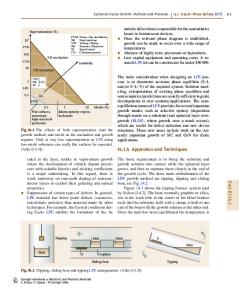Crystal face and C/Si ratio Dependence of Phosphorus Doping by SiC Epitaxial Growth
- PDF / 118,004 Bytes
- 5 Pages / 612 x 792 pts (letter) Page_size
- 109 Downloads / 336 Views
0911-B05-26
Crystal face and C/Si ratio Dependence of Phosphorus Doping by SiC Epitaxial Growth Takeshi Tawara, Yuko Ueki, Shunichi Nakamura, Masahide Gotoh, Yoshiyuki Yonezawa, and Masaharu Nishiura Fuji Electric Advanced Technology Co., Ltd., 4-18-1, Tsukama, Matsumoto, Nagano, 3900821, Japan
ABSTRACT To make the highly doped layer for Ohmic contact without using the ion implantation, the phosphorus doping by the epitaxial growth using phosphine (PH3) was conducted. The crystal face and C/Si ratio dependence of phosphorus doping were investigated. The highest doping concentration was obtained on off-axis (000-1) face and the lowest on off-axis (0001) face. The doping level of (11-20) face was located between that of off-axis (0001) and (000-1) faces. As the C/Si ratio was increased from 0.5 to 2.5, the doping concentration increased on (11-20) and off-axis (000-1) faces. The results on off-axis (0001) face showed the unclear C/Si ratio dependence. On (000-1) face, the phosphorus doping of 2 × 1018 cm-3 was obtained by increasing PH3 flow rate. The roughness, growth rate, and surface morphology of the high phosphorus doped epilayer were investigated. INTRODUCTION Phosphorus and nitrogen are known as the common n-type dopant in SiC. Especially by the ion implantation, phosphorus can be doped exceeding 1 × 1020 cm-3, which is higher concentration over that of nitrogen (about 1019 cm-3) [1]. Implanted layer with high doping is required to reduce the resistivity of Ohmic contact and the source/drain area in field-effect transistors. The high dose implantation needs a subsequent high temperature anneal (>1600 °C) to activate dopants and to repair crystal defects [2]. However, such extremely high temperature annealing causes some serious problems such as evaporation of the implanted layer and redistribution of the implanted dopants, which increase the surface roughness of the implanted layer. It is easily predicted that these annealing induced defects would degrade the performance of SiC devices fabricated on the implanted layers. On the other hand, the phosphorus doping by the epitaxial growth has been attempted by some researchers. However, the low phosphorus concentrations of 3 – 4 × 16 cm-3 (Si-face) [3, 4], 9 × 17 cm-3 (C-face) [4] have been reported. Furthermore, the dependence of the phosphorus doping on the crystal face is not reported so far. In this study, we investigated the crystal face and C/Si ratio dependence of phosphorus doping by the epitaxial growth in 4H-SiC. Besides the roughness, growth-rate, and surface-morphology of the high phosphorus doped epilayer were also investigated. EXPERIMENT Phosphorus doped 4H-SiC epilayers were grown on 8° off-axis (0001), (11-20), 8° off-axis (000-1), and (03-38) substrates in a low-pressure horizontal hot-wall CVD reactor using
H2 as a carrier gas, SiH4, C3H8, and PH3 as the sources of Si, C, P respectively. The net doping concentration (Nd-Na) and the phosphorus concentration were determined by C-V measurement using Ni as a schottky contact and SIMS measurement.
Data Loading...











